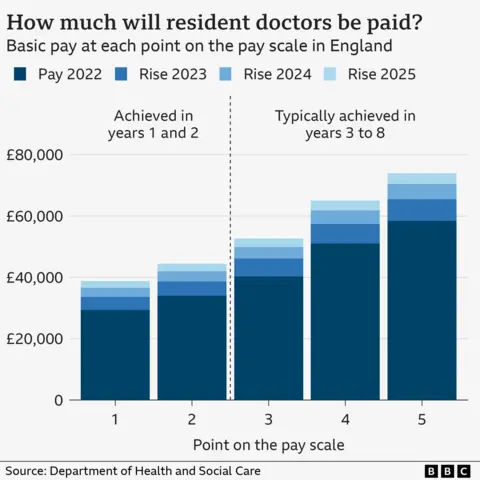Published: 25th July ‘2025 | The English Chronicle Desk | The English Chronicle Online
A fresh wave of industrial unrest has once again struck the heart of the UK’s National Health Service, as resident doctors—previously known as junior doctors—embark on a five-day walkout across England in their continuing dispute over pay and working conditions. This latest strike, which began on Friday, has prompted the government and health service leadership to adopt new strategies in a bid to contain disruption and safeguard patient care.
Health Secretary Wes Streeting, while acknowledging the inevitable challenges ahead, has vowed to minimise the strike’s impact on patients and ensure that essential NHS services continue. In a departure from previous approaches, NHS England has advised hospitals to cancel appointments or procedures only in exceptional circumstances. Unlike earlier walkouts, which placed a clear emphasis on sustaining emergency services at the expense of routine care, this time the health service is taking a broader approach—attempting to preserve both urgent and non-urgent care through senior clinician cover.

But the situation remains fraught with uncertainty. Senior doctors have once again been tasked with filling the staffing gap left by striking resident doctors, marking the twelfth such industrial action since the dispute first erupted in early 2023. The British Medical Association (BMA), representing the doctors, has expressed deep concern that this new model risks overwhelming those who remain on the frontline, warning that safety could be compromised if staff are stretched too thinly.
Prime Minister Sir Keir Starmer, writing in The Times ahead of the strike, urged resident doctors to reconsider their course, warning that the strike action could jeopardise the hard-won progress made in rebuilding the NHS over the past year. He accused the BMA of rushing into further conflict and claimed the strikes posed a significant setback both for the health service and the nation at large.
Streeting echoed that view, acknowledging the damage the walkouts could inflict but insisting that the Government would do all it could to protect patient care. “There is no getting around the fact that these strikes will hit the progress we are making on turning the NHS round,” he said. “But I am determined to keep disruption to patients to a minimum.
Despite these assurances, past walkouts paint a sobering picture. Since March 2023, more than one million hospital appointments and treatments have been cancelled due to resident doctor strikes. Some hospitals previously managed only half of their normal patient loads on strike days. This time, however, NHS officials say they are adopting a revised strategy, with some hospitals planning to operate at full capacity. According to internal NHS sources, the service has “learnt lessons from the past strikes—this one will feel very different.”
Nonetheless, the looming disruption is already being felt. Hassnain Shahid, a father from Bradford, revealed that his three-year-old daughter’s lung surgery, scheduled for Monday, has been cancelled. The child suffers from a rare condition, and any delay in treatment carries a serious risk to her health. “It’s been an emotional rollercoaster,” Shahid said. “It’s very frustrating.
While the majority of striking doctors are based in hospitals, the impact is likely to be felt beyond, with GP practices and community health services also facing staff shortages. Resident doctors now account for nearly half of England’s medical workforce, and around two-thirds are members of the BMA. NHS England’s Medical Director Prof Meghana Pandit stressed the importance of maintaining routine care, warning that repeated delays to non-urgent operations such as hip replacements and hysterectomies could lead to both physical and psychological harm. “It’s really important to reduce cancellations,” she said. “Rescheduling appointments has real-world consequences for patients.”
However, the BMA remains unconvinced. In a letter to NHS England, the union has argued that attempting to maintain routine care during a mass strike could in fact worsen conditions and endanger safety. They suggest a return to the previous strategy of scaling back non-urgent care during strikes would be more prudent.
Despite these concerns, hospital leaders remain optimistic that services can be maintained without crossing critical safety thresholds. Saffron Cordery, deputy chief executive of NHS Providers, explained that hospitals were operating under strict safety guidelines and making decisions on a day-to-day basis. She also noted the unpredictability of the situation, as doctors are not required to notify hospitals in advance of their participation in the strike. “Nobody will know until they actually turn up for their shifts or not,” she said.
The political dimensions of the crisis continue to deepen. Conservative shadow health secretary Stuart Andrew laid the blame squarely on the government, accusing Labour of failing to hold firm in last year’s pay negotiations. “Labour’s spineless surrender to union demands last year opened the door to this,” he said. “They handed out inflation-busting pay rises without reform, and now the BMA is back for more.”
Meanwhile, Rory Deighton of the NHS Confederation acknowledged the complexity of the dispute but placed ultimate responsibility for the disruption on the BMA, stating: “The impact of these strikes and the distress they will cause patients rests with the BMA.”
As the five-day strike unfolds, the country watches closely to see whether the Government’s new strategy of balancing emergency and routine care can withstand the pressure. What remains clear is that, until an agreement is reached, the NHS will continue to be caught in a cycle of disruption, placing mounting strain on staff, patients, and a healthcare system already battling to recover from years of crisis.





























